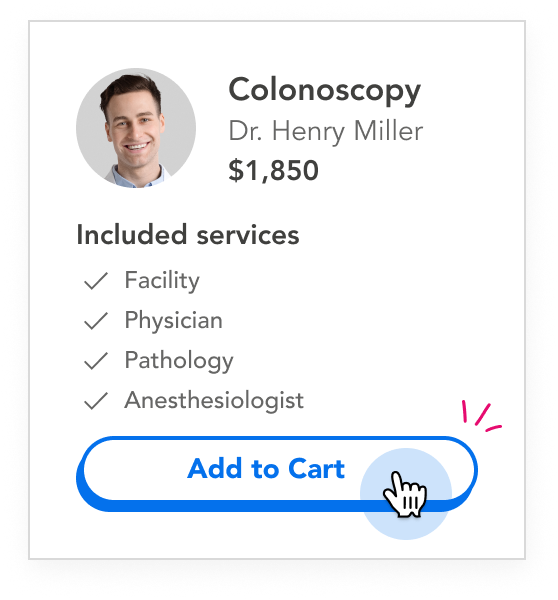Adjustable Gastric Band Surgery in the Knoxville Region
Save by purchasing this procedure online.
National Average 35,365
Regional Average15,415Save $19,950
Financing Options
Promotional financing available when you pay with CareCredit. $200 minimum purchase. What is CareCredit?
Beasley, MD, Dr. Mariah
Bariatrics
4.9
7557B Dannaher Dr. | Suite 225
Powell, TN 37849
Offered by

Lodeiro, MD, Dr. Megan
Bariatrics
10800 Parkside Drive | Suite 330
Farragut, TN 37934
Offered by

Money Back Guarantee
We will refund your payment in full if you end up not needing your purchased procedure and do not receive care. Details
Get Care In Three Easy Steps
Compare Upfront Prices

Search by procedure and location to browse local providers and compare upfront pricing.
Buy Your Procedure

Pay for your procedure online or by calling (844) 256-7696. Or buy your procedure at the facility before your appointment is scheduled.
Receive Your Care

Follow the scheduling instructions given by your provider. Bring your voucher to your appointment.
Frequently Asked Questions
View All FAQsAdjustable Gastric Band Surgery Cost in the Knoxville Region
Save by purchasing this procedure online.
Procedure Details
What is an Adjustable Gastric Band?
The adjustable gastric band promotes weight loss by reducing the amount of food that the stomach can hold. An inflatable band placed around the top of the stomach creates a small pouch that holds significantly less food and causes the patient to feel full more quickly, while still allowing food to pass through the rest of the stomach and small intestine as normal. The body is able to absorb calories and nutrients normally with a gastric band.
After the gastric band is installed, the size of the opening between the small top pouch and the rest of the stomach is reduced over time via adjustments of saline, called “fills”. These fills are administered via a needle injected into an access port surgically placed under the skin, which connects to the band via a small tube. The doctor will adjust the size of the stomach opening based the rate of weight loss, and can either add fluid to tighten the band or remove fluid to loosen it. Band adjustments are made at follow-up office visits.1
What Can You Expect During a Gastric Band Surgery?
Bariatric surgery is performed in the hospital, under anesthesia. Recovery typically takes place in the hospital or surgical center, where the hospital staff can monitor the patient for any complications.2 Gastric banding is a laparoscopic surgery, which is a minimally invasive technique that uses small incisions to implant the band and place the access port beneath the skin. The recovery from this surgery typically requires a hospital stay of 24 hours or less, and some patients may be discharged the same day as their surgery.
After surgery, gastric band patients have to follow a special diet that helps the stomach acclimate to its new size. This eating plan typically starts with clear liquids, then progresses into pureed food, soft food, and eventually, solid food on a medically-monitored nutrition plan. Patients will only need to eat a small amount of food before feeling full, and the exercise and nutrition plan is designed to help patients form new, healthy habits and reinforce the need to stop eating before overeating occurs.
Are You a Good Candidate for Gastric Band?
Weight loss surgery like gastric banding may be recommended for severely obese patients, meaning they have a BMI of 40 or higher. In some cases, patients with a BMI of 35 or higher
may qualify if they also suffer from obesity-related health problems like diabetes, sleep apnea, joint pain, heart disease and hypertension.34 In addition, most patients must have tried and failed to lose weight through traditional diet and exercise before bariatric surgery will be considered. Check with your insurance company to see if they cover any bariatric surgery, and if so, what requirements must be met.
Before undergoing weight loss surgery, most patients will have to go through a screening process. Patients must be willing to follow a nutrition and exercise plan to both achieve and maintain a healthy weight, and commit to follow-up visits and possibly vitamin or mineral supplementation.5 A patient must also be healthy enough for surgery, both physically and mentally. A psychological evaluation is typically included in pre-operative screenings. Doctors must determine if the benefits of bariatric surgery outweigh the risks before the procedure will be performed.
What is the Difference Between Gastric Banding, Gastric Bypass, and Gastric Sleeve?
The biggest difference between gastric banding and gastric sleeve or gastric bypass surgery is that the gastric band does not require any cutting of the stomach or rerouting of the digestive pathway, which means gastric banding is completely reversible and adjustable. Gastric sleeve, or sleeve gastrectomy, entails the removal of about 75 - 80 percent of the stomach, leaving a banana-shaped tube that is sealed with staples. Like gastric banding, gastric sleeve does not alter the path that food takes through the body. Gastric bypass, on the other hand, reroutes food from the top of the stomach to a lower section of the small intestines, bypassing the lower stomach and upper portion of the small intestines entirely.
Gastric banding tends to have a quicker recovery than either gastric sleeve or gastric bypass, and has a lower incidence of surgical complications. Some surgical centers release gastric band patients the same day of surgery, and most patients are released within 24 hours. Gastric sleeve recovery typically takes about two days, and gastric bypass recovery can take between three and five days. Because the stomach remains intact in gastric banding surgery, the risk of vitamin or mineral deficiencies is lower than in either gastric bypass or gastric sleeve.
However, gastric banding does tend to see a slower rate of weight loss than gastric sleeve or gastric bypass. Gastric band surgery generally results in an average 40 to 50 percent loss of excess weight, whereas gastric sleeve typically produces more than 50 percent excess weight loss and gastric bypass averages about 77 percent of excess weight loss.
What are the Benefits and Risks of Gastric Band Surgery?
The gastric band helps encourage healthy eating habits and reduced calorie intake by making patients feel full faster. Because the mechanisms to absorb vitamins and nutrients are unaltered by a gastric band, this procedure has the lowest risk of vitamin and mineral deficiency. Unlike the other bariatric surgeries mentioned here, gastric banding surgery is both reversible and adjustable and has the lowest complication rate. The surgery itself only takes about 30 to 60 minutes to perform.
Weight loss from a gastric band may come more slowly than other bariatric procedures and requires that the patient take care not to overeat, as dilation of the esophagus can occur as a result. Maintenance of weight loss will require mindful adherence to a medically monitored diet and exercise plan to establish healthy eating habits. The gastric band is a foreign object implanted in the body, and so there is some risk that problems with the device can occur, like band slippage or erosion.
What Other Conditions Can Be Improved by Bariatric Surgery?
Weight loss surgery can improve quality of life for many patients struggling with obesity, including making it easier to perform everyday activities. In addition, bariatric surgery can help alleviate symptoms of other obesity-related conditions:
- Gastroesophageal reflux disease (GERD)
- Obesity-related heart disease
- High blood pressure (hypertension)
- Sleep apnea
- Type 2 diabetes
- Weight-related stroke
1 https://www.hopkinsmedicine.org/healthlibrary/test_procedures/gastroenterology/laparoscopic_adjustable_gastric_banding_135,63
2 https://www.mayoclinic.org/about/pac-20394258
3 https://www.marinahospital.com/blog/who-is-a-good-candidate-for-gastric-sleeve-surgery
4 https://asmbs.org/patients/who-is-a-candidate-for-bariatric-surgery
5 https://www.mayoclinic.org/about/pac-20394258M
Procedures
© Copyright 2025 MDsave Incorporated.
All Rights Reserved.



